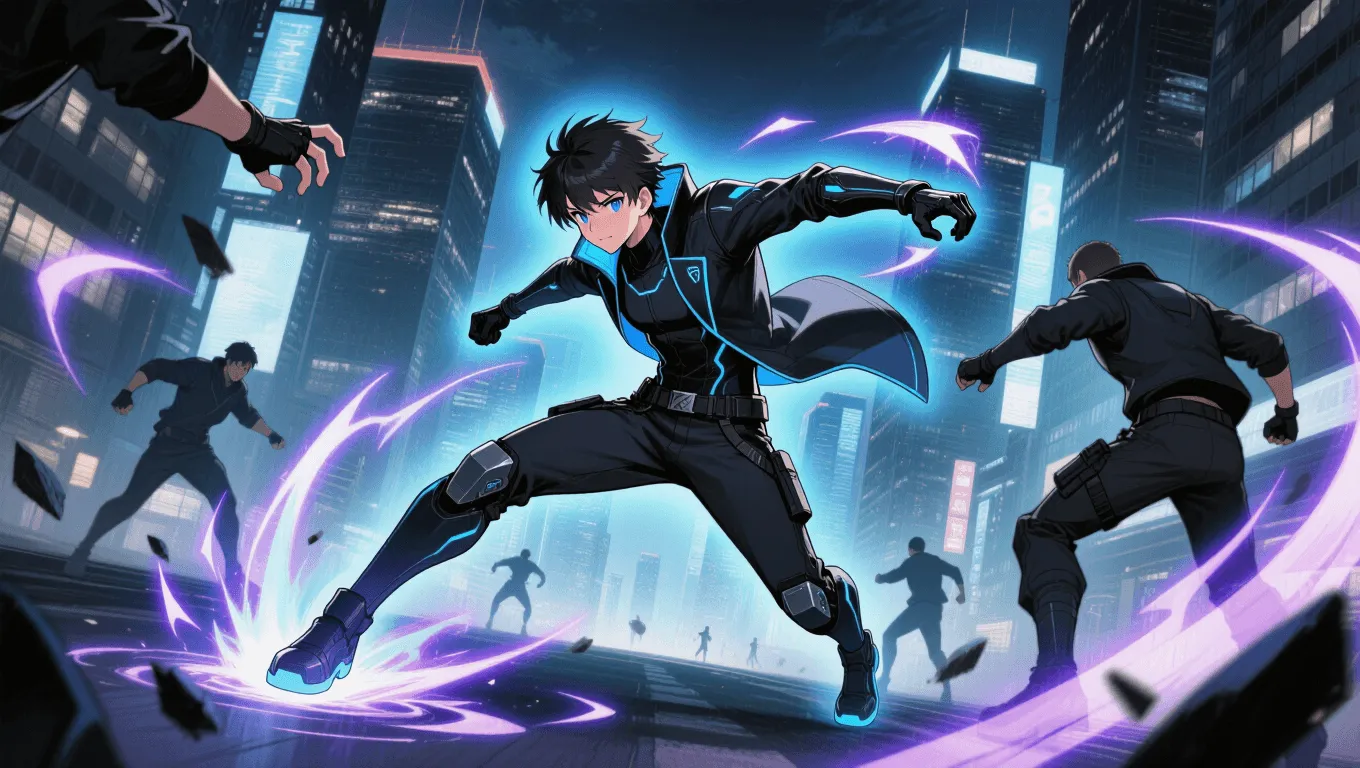Teleportation

Teleportation Video Demo 🎬
Table of Contents
What Is Teleportation
Teleportation is the ability to relocate instantly from one point to another without traveling through the space in between. In many stories, teleportation is described as folding space, opening a portal, or performing a blink that moves the user in a heartbeat. As a mobility-focused power, it turns movement into a strategic tool, letting a character evade danger, strike from new angles, and cross obstacles in ways no vehicle or conventional speed can match. In the broader context of powers, it is a frequent headliner in the superpower wiki and a favorite result in our random superpower generator.
Writers and worldbuilders often differentiate types: short-range blink teleportation (line-of-sight hops), long-range relocation (city to city), portal creation (stable doorways), spatial warping (folding space), and dimensional travel (between realms). Related terms that appear in fiction include instant transmission, jump, warp, phase skipping, waypoints, wormhole stepping, and quantum “tunneling” analogies.
Core Abilities of Teleportation
-
Instant relocation: Move from origin to destination in effectively zero time, bypassing terrain, walls, traps, and crowds.
-
Line-of-sight and memorized jumps: Many users can jump to places they can see, precisely mark, or remember well; advanced users lock to coordinates or beacons.
-
Passenger and cargo carry: Bring gear or people along; some users can mass-teleport squads or heavy objects.
-
Portal creation: Open persistent gateways others can traverse; useful for logistics, evacuations, and battlefield repositioning.
-
Waypoint marking: Tag safe arrival points (rooftops, balconies, behind cover) to enable rapid, repeatable routes.
-
Dimensional or planar travel: Step across parallel worlds or pocket dimensions, bypassing conventional barriers entirely.
-
Blink chaining and combat blinking: String multiple short jumps together to weave through hostiles or move unpredictably mid-fight.
-
Teleport redirection and recall: Pull an ally to safety or swap places with a target for sudden positional advantage.
Application / Tactical Advantages in Combat
Teleportation is a positional superpower—victory through superior placement. Its main tactical advantages include:
-
Guaranteed initiative: Start fights from ideal angles. A user can appear on high ground, behind cover, or directly at an objective before adversaries react.
-
Perfect flanking and backline access: Bypass shields and chokepoints to reach commanders, support casters, or artillery, forcing the enemy to split focus.
-
Unparalleled dodge potential: Blink just before impact, escaping explosives, grapples, or line-targeted beams. Short micro-teleports confound aim assist and predictive fire.
-
Rapid extraction and rescue: Evacuate wounded allies, retrieve hostages, or remove volatile items (bombs, cursed artifacts) from a hot zone.
-
Logistics and tempo control: Shuttle ammo, medkits, or reinforcements. Establish portals to maintain pressure, rotate teams, and outpace opponents’ repositioning.
-
Terrain rewriting: Turn vertical arenas, minefields, and labyrinths into straight lines; deny the enemy the benefits of fortifications and traps.
-
Hit-and-fade strikes: Blink-in, strike, blink-out cycles erode enemy stamina and morale while minimizing exposure.
Micro-Tactics
-
Pre-marked safe spots: Seed the field with memorized waypoints behind hard cover and at cross-angles.
-
Teleport feints: Fake to a common perch, then appear at a secondary mark to bait enemy fire.
-
Swap and isolate: Trade places with a tanky ally to disengage them, or with an enemy to strand them in unfavorable positions.
Level: Level 1 🏙️, Level 2 🌇, Level 3 🌃
Level 1 🏙️ — Street-Scale Blink
At entry level, the user performs short-range blinks of 1–20 meters, typically requiring line of sight or a clear mental picture. This level excels at:
-
Evasion: Dodging projectiles, melee lunges, grapples, and area-of-effect bursts.
-
Close-quarters repositioning: Hopping behind foes, onto ledges, or through doorways to manipulate angles.
-
Solo mobility: Carry weight is limited to personal gear or one light passenger; repeated use can cause brief dizziness.
-
Cooldown awareness: Early users often need rhythm—blink, reorient, act—rather than continuous chaining.

Level 2 🌇 — City-Scale Jumps
Mid-tier teleporters stretch to city blocks or districts. They can often carry one or two companions reliably, with:
-
Waypoint memory: Reliable returns to scouted rooftops, safe houses, and rally points.
-
Portal slits: Brief windows that allies can step through; useful for squad rotations and flanking maneuvers.
-
Counter-ambush potential: Instantly respond to alarms, appear where needed, and collapse on exposed threats.
-
Load management: Heavier cargo or multiple passengers increase fatigue and reduce accuracy, demanding planning.

Level 3 🌃 — Continental & Dimensional Travel
Top-tier users traverse cities, continents, or realms with precision:
-
Strategic logistics: Move teams, vehicles, and supplies; establish stable portals for sustained operations.
-
Dimensional traversal: Slip to parallel layers (shadow realms, pocket spaces) to bypass barriers, prison cells, or kill-zones.
-
Combat omnipresence: Pressure across multiple fronts, set multi-angle kill boxes, or instantly reinforce allies.
-
High-risk management: Long jumps amplify errors; miscalculations may drop a team into hazards or anti-teleport fields.

Limitations of Using the Teleportation
-
Line-of-sight or familiarity requirements: Many systems restrict jumps to places the user can see, has visited, or has tagged. Unfamiliar locations risk misplacement.
-
Energy and fatigue: Each jump taxes stamina or a power pool; heavy loads, repeated chaining, or long distances accelerate burnout.
-
Momentum and orientation: Arriving mid-air, facing the wrong way, or inheriting prior motion can cause falls, stumbles, or friendly collisions.
-
Interference and wards: Anti-teleport fields, jamming sigils, dimensional anchors, or Faraday-like cages can block or scatter arrivals.
-
Environmental hazards: Arriving inside moving machinery, toxic zones, or low-oxygen spaces is dangerous without pre-scan abilities.
-
Cooldowns & precision drift: Some systems enforce cooldowns; long-range or high-stress jumps can widen arrival error, requiring buffer zones.
-
Passenger consent and stability: Unwilling or panicked passengers can destabilize a group jump, increasing the chance of separation.
Weakness against what other superpowers
-
Precognition and danger sense: Foes who anticipate the arrival point can pre-aim traps, mines, or counterstrikes.
-
Spatial anchors and anti-teleport barriers: Dimensional locks, gravity wells, or reality anchors limit or cancel jumps.
-
Time dilation and speed manipulation: Time-stoppers and speedsters can punish post-arrival lag or exploit the micro-window between reappearance and action.
-
Telepathy and mind disruption: Concentration breaks—induced fear, illusions, or psychic static—cause misjumps or failed casts.
-
Area denial fields: Persistent flames, storms, frost domes, or corrosive clouds blanket likely arrival zones.
-
Tracking and recall powers: Tagging, tethering, or recall marks allow enemies to follow or yank the teleporter back.
-
Sealing and binding: Chains, force bubbles, or stasis cages prevent the user from initiating the jump gesture or thought.
Synergistic Power Combos
-
Teleportation + Invisibility: Silent infiltration and perfect ambushes; appear, strike, vanish without a trace.
-
Teleportation + Telekinesis: Deliver thrown weapons or debris through portals; yank enemies into traps from afar.
-
Teleportation + Illusion Casting: Mask the true arrival point with decoys; layer feints for head-spinning misdirection.
-
Teleportation + Energy Manipulation: Port fire, lightning, or hard-light constructs into blind spots; create cross-fire from impossible angles.
-
Teleportation + Precise Sensing (echolocation, radar, clairvoyance): Safely jump into unseen rooms; pre-scan for hazards and set ideal landing pads.
-
Teleportation + Healing/Shielding: Emergency med-evac plus instant return to frontline after stabilizing allies.
-
Teleportation + Gravity Control: Drop enemies from height, nullify fall damage for allies, or pin foes at arrival.
-
Teleportation + Mark & Recall: Place beacons throughout a city, enabling a private “subway” of safe instant routes.
Known Users
-
Nightcrawler—a signature short-range “bamf” user who excels at acrobatic blink chaining and rapid flanking.
-
Blink—portal specialist whose discs double as offense and team transport.
-
Magik—teleports via stepping discs that route through a demonic realm, enabling both travel and battlefield control.
-
Cloak—moves through and imprisons foes in a shadow dimension, blending teleportation with containment.
-
Tracer—a video-game icon known for short blinks and time-skipping repositioning.
These examples show how varied techniques—blink teleportation, portal creation, and dimensional stepping—shape both narrative roles and combat identities. For even more abilities related to movement, stealth, and space, browse our growing superpower wiki or spin the random superpower generator for inspiration.
